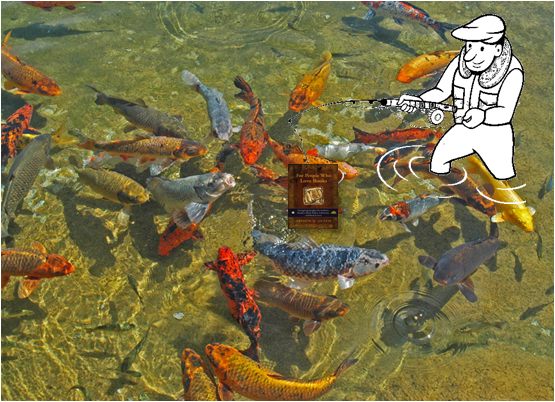It's not enough to be a good storyteller and an excellent writer in today's world. Now, more than ever you need to hit a specific demographic to generate large sales. Traditional publishing houses have relatively strict definitions about the definitions of specific genres and the genres they will accept. Often, they expect an author to come to them with a ready-made definition of the ideal reader.
As a self-published author identifying your target reader requires research and a detailed knowledge about the readership of recently successful similar titles. A well-defined target is critical in order to gain their attention. When self-publishing its all you and your ability to target the right fish and contiue to feed them!
Read Your Genre: Know Your Market and Who is Successful
Read as many books as possible in your genre so that you know what sells. Knowing what is popular with the "fish" (you get the point) will help you when you start to work on your pitch. If you can easily describe your book in a way that potential readers can identify with, your pitch has a better chance of success.
When you have discovered several books that are comparable to yours, scour the Internet to see what kind of feedback the readers are providing. You will learn over time whether your book is likely to appeal to readers of a certain age, a gender or a special interest group or other demographic characteristic. When you know your target audience well, it will help you to hone your pitch.
Research: What They Eat and Where They Live
As you find sites where people are discussing similar books, join the group and join the online conversation. Don’t start by suggesting they should read your book, but do join in existing threads with comments or questions and eventually start some of your own threads. Over time, you will begin to form an even clearer picture of your potential reader, and that will help you understand how to best market and position your book when you are finally ready to publish.
As you become a known presence on existing sites, people will follow you to your own website or blog. To attract readers, you can post sample chapters, or run contests to build enthusiasm and anticipation for your book so that you have a ready and eager audience when your book is ready.
Consider a Professional: Maybe Use a Guide the First Time?
Many authors have difficulty juggling writing, building a social media presence and holding down a job or family responsibilities. Of course, writers are writers, not necessarily marketing people, so you may find it helpful to engage with a reliable and professional book marketing service. A good service can save you time and money by steering your marketing investment to the right channels to improve your readership and distribution. It can also be the most efficent way to learn a few tricks that you can continue with yourself!
An Editor Can Add Polish: Make the Food Taste Better!
If you are hoping to attract good word of mouth that might lead to a traditional publishing contract, you might also want to consider professional editing for your manuscript. Even the best writers have blind spots when it comes to their own writing, and relying on friends and family probably won’t be effective. A professional editor can improve the readability and professional appearance of your book son typos and errata don’t distract the reader.
Independent publishing gives you more leeway in finding and addressing a target market than traditional routes do, but you should still have a target reader in mind when you publish independently because it will help you market your book more successfully. Knowing your target audience in advance may even influence stylistic decisions as you polish your manuscript.
Self-publishing success stories
Occasionally authors are concerned that self-publishing their work will hurt their careers, but that is not the case. Many famous and successful authors started with self-published works. For example:
-
E.L. James, author of Fifty Shades of Grey, originally published the stories as fan fiction on the Internet. The trilogy has now sold over 70 million copies and counting.
-
Another author, Amanda Hocking, self-published her early novels. In a single year, she sold more than 1 million copies and earned $2 million from her self-published work. Traditional publishers noticed her success, and she has gone on to earn additional millions as a bestselling author.
Don’t think that only authors of paranormal or romances can be successful with self-publishing. John Grisham, one of the best-selling authors of all time, self-published his first novel, A Time to Kill. He later went on to publish his additional work through more traditional publishing, and the fact that his earliest work was self-published has never tarnished his reputation.
Other respected authors that started with self-publishing include Upton Sinclair, Zane Grey, Deepak Chopra, Mark Twain, Gertrude Stein and Anais Nin, among many others. Each of these authors had a clear image in mind of who their reader would be, and self-publishing started them on the road to success as an author.
Find the fish and feed them the food they love to eat!



